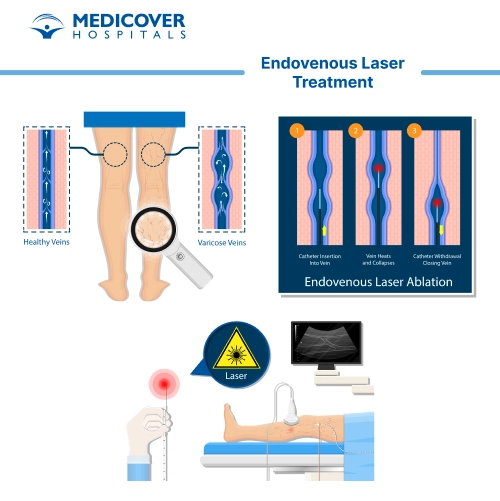What is EVLT and its Purpose?
Endovenous Laser Treatment (EVLT) is a state-of-the-art medical procedure aimed at treating varicose veins, which are characterized by their unsightly appearance and often painful symptoms. This procedure seeks to rectify the underlying causes of varicose veins by redirecting blood flow away from the affected veins and promoting improved circulation. Beyond its aesthetic benefits, EVLT alleviates discomfort, reduces swelling, and enhances overall leg health.
What They Do for EVLT Procedure?
The EVLT procedure is a collaborative effort involving skilled medical professionals, state-of-the-art equipment, and precise techniques. A qualified vascular surgeon or an interventional radiologist spearheads the procedure. They collaborate closely with a team that includes nurses, technicians, and support staff. This collective expertise ensures that the procedure is performed smoothly, adhering to the highest medical standards.
If you're considering the EVLT procedure, your journey begins with consulting a vascular specialist. This specialist will be your guiding light, assessing your unique condition, discussing the procedure's suitability for you, and addressing any concerns you may have. By establishing a partnership with a reputable medical provider, you're taking the first step towards improved vein health.
How to Prepare for EVLT?
Effective preparation is crucial for a successful EVLT procedure. Here's how to prepare:
- Consultation: Schedule an initial consultation with a vascular specialist. During this appointment, your medical history will be reviewed, and any necessary tests or imaging will be conducted to assess your veins' condition.
- Follow Instructions: Your medical provider will offer specific instructions tailored to your needs. These instructions may involve adjusting medications, fasting before the procedure, and adhering to any pre-procedure guidelines.
- Arrange Transportation: Due to the use of local anesthesia or sedation, arranging for transportation to and from the medical facility is advised.
What Happens During EVLT?
The EVLT procedure is a meticulously orchestrated process designed for optimal results. Here's what occurs during the procedure:
- Anesthesia: Local anesthesia is administered to numb the treatment area, ensuring your comfort.
- Laser Fiber Insertion: A tiny incision is made near the varicose vein, and an ultrasound-guided thin laser fibre is introduced into the vein.
- Laser Energy Application: The laser fiber delivers controlled bursts of energy, causing the vein to heat up and close off.
- Compression Dressing: Following the procedure, a compression dressing or stocking is applied to support healing and prevent blood pooling.
Recovery After EVLT Procedure:
The recovery phase after EVLT is characterized by its relatively quick timeline and manageable discomfort:
- Immediate Post-Procedure: Expect mild discomfort, bruising, and swelling around the treated area. These symptoms typically resolve within days.
- Physical Activity: Light activities such as walking are encouraged to promote circulation, while strenuous activities should be avoided temporarily.
- Compression Garments: Wearing compression stockings supports healing and minimizes swelling.
- Follow-Up Appointments: Scheduled follow-up appointments allow your medical provider to monitor progress and address any concerns.
Lifestyle Changes After EVLT Procedure
Post-EVLT, embracing certain lifestyle changes contributes to lasting vein health:
- Regular Exercise: Engaging in low-impact exercises boosts circulation, aiding overall vein health.
- Nutritious Diet: Opt for a diet rich in nutrients, antioxidants, and fiber to support cardiovascular well-being.
- Weight Management: Maintaining a healthy weight reduces strain on veins.
- Movement: Avoid prolonged sitting or standing; take breaks to move and stretch.
- Hydration: Staying hydrated supports circulation and vein elasticity.
Conclusion:
Endovenous Laser Treatment (EVLT) is a transformative procedure that addresses varicose veins with precision and effectiveness. By understanding the procedure, collaborating with qualified medical professionals, following pre and post-procedure guidelines, and embracing positive lifestyle changes, you embark on a journey towards healthier veins and improved overall well-being. If varicose veins have been a source of discomfort, EVLT presents a path to a future marked by pain relief, enhanced circulation, and renewed confidence in your legs' health.
Citations
Endovenous laser therapy (EVLT)
Endovenous Laser Varicose Vein Surgery
Endovenous Laser Varicose Vein Surgery
3 Advantages of Endovenous Laser Ablation Therapy (EVLT)
Endovenous Laser Treatment for Varicose Veins


